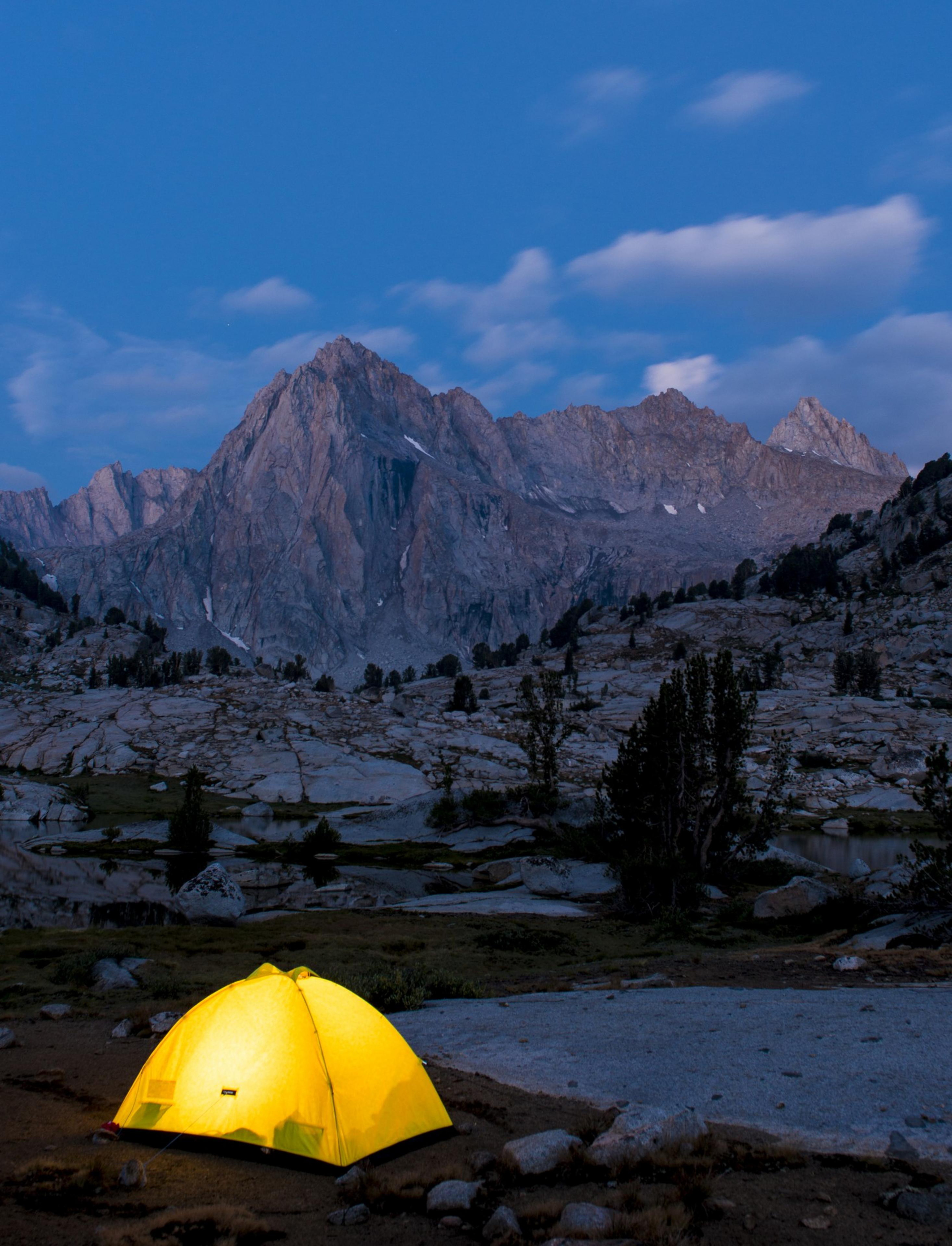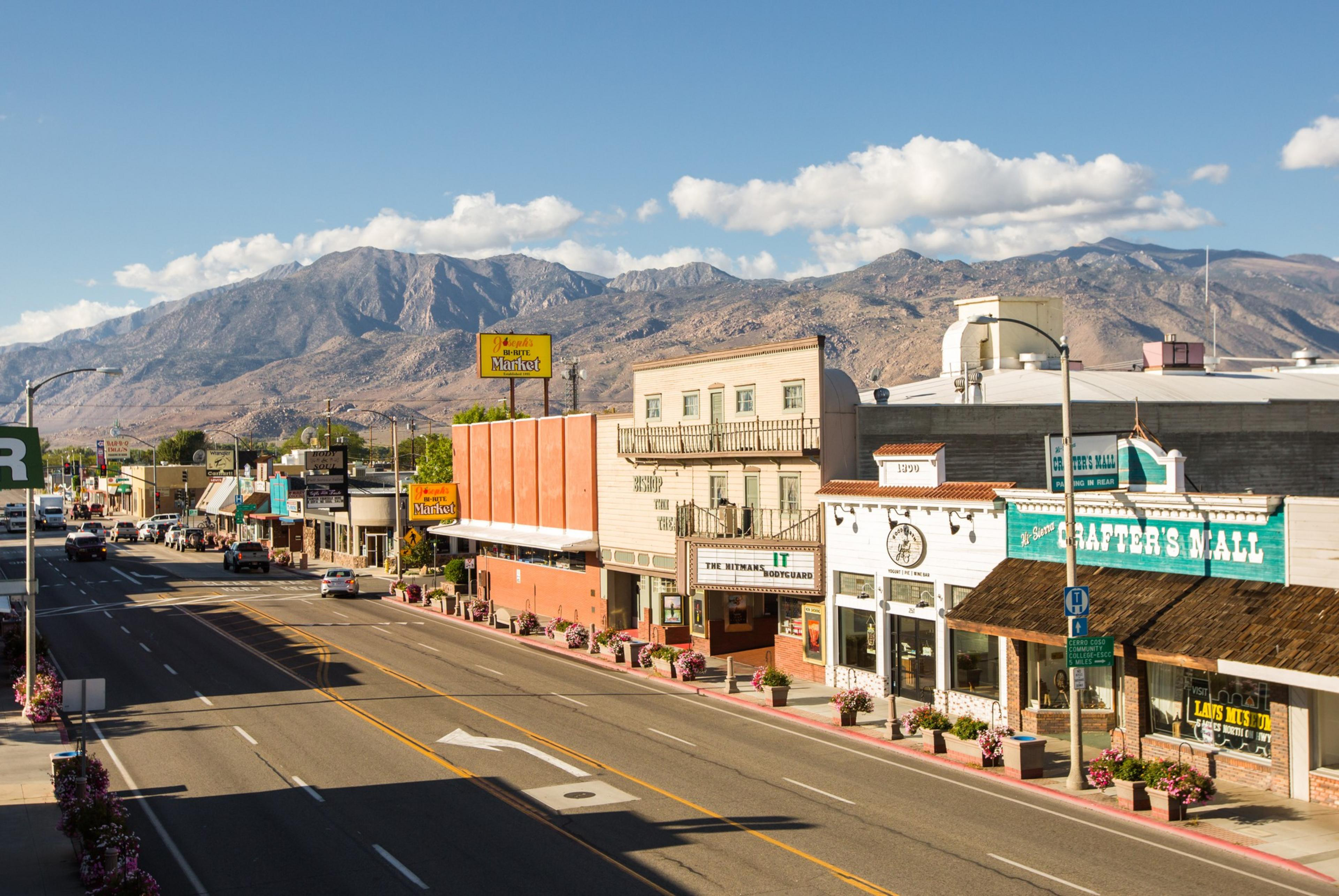No matter which route you take, what time of year it is or what time of day you leave, the drive from San Francisco to one of the most beautiful places in California takes at least six hours. But as anyone who’s trekked over the Tioga Pass and down the spectacularly scenic eastern side of the Sierra Nevada can tell you, the journey to Bishop is worth it.
Even in a state famous for its geographical wonders, Bishop is unique, a community of about 4,000 people that’s the largest city for a hundred miles in every direction. Increasingly a haven for climbers, cyclists and hikers coming off the John Muir and Pacific Crest trails to reup on supplies, Bishop also has crunchy coffeehouses, brewpubs and a bowling alley marked with an oversized bowling pin in the bed of a vintage pickup. There’s a century-old twin theater, the 117-year-old Eric Schat’s Bakery (best known for its Basque-style “sheepherder” bread) and a clutch of motels with kitschy neon signage.

Towering above it all, on both sides of the valley, are the mountains. To the west is the spine of the central Sierra, snowy even in summer. To the east are the Inyo and White Mountains, home to the gnarled bristlecone pines. Together, they make sunrise and sunset a majestic event. Idyllic streams flow down through the narrow Owens Valley, and directly under Main Street. Only 40 miles north, the considerably more upscale Mammoth Lakes remains a magnet for Southern California skiers and second-home owners. Yet Bishop is only just getting discovered.
Warm welcome in the middle of nowhere
For all its virtues, the downside remains: Bishop can be very hard to reach. When State Route 120 running through Yosemite is closed—as it can be all the way through July depending on that winter’s snowpack—Bay Area drivers may have to detour as far north as Reno to pick up Interstate 80, adding 125 miles to the journey. But Bishop’s remoteness can lead to a communitarian ethos that, for some residents, is part of the magic.
“I hadn’t prepared for the kindness that I found here,” said Deena Davenport, a hairdresser who relocated from San Francisco to Bishop in 2017. She lives with her wife in a trailer on a friend’s property in town, while they build their future home in the mountains.
She’s also the driving force behind Eastern Sierra Pride (opens in new tab), an LGBTQ+ festival held at the Inyo County Fairgrounds on the first weekend in June—one week after Mule Days (opens in new tab) and one week before the California High School Rodeo Association finals (opens in new tab).
Inyo County, which flipped narrowly from red to blue in 2020, is politically split, with hippies, coastal transplants and an indigenous community on one side, and libertarians, evangelical Christians and fourth-generation ranching families on the other. But these divisions haven’t torn Bishop to shreds. “Here, you can know someone who’s MAGA, but they’re still your neighbor,” Davenport said. “I really appreciate that.”
Still, everyday life has its inconveniences. Supermarkets have what Davenport called “resort pricing,” which causes residents to bristle, as there aren’t many resorts to speak of. “We pay more for groceries than people in San Francisco do,” Davenport said. “And they actually go bad faster, because [truckers] shut the fridges off in the desert.”
To cope, many people grow their own food and share what they have. Davenport and her wife host a weekly “Coffee Church” at the Inyo Valley Roasting Company every Sunday morning, providing a place for progressives, queer folks and others to gather.

Hikers, though, may be the group most attracted to the town. Residents cite the ever-growing popularity of the 2,600-mile Pacific Crest Trail (opens in new tab), which snakes west of Bishop, as a particular boon. (The number of permits issued nearly quadrupled from 2013 to 2022 (opens in new tab).) In June, two such hikers—Maryland native Suds Siskind and Chuck Dispa, a Belgian—were part of a multinational group that found each other in the mountains. They were on Day 62 or 63 (they couldn’t recall exactly) of their northward odyssey, and agreed that Bishop was the most beautiful town they’d encountered in weeks.
“Everybody wanted to stay another day here,” Dispa said.
The duo was spending the night at The Hostel California (opens in new tab), a purple-and-teal storybook house with space for 40 people that was at capacity, according to employee Matt Sadzewicz. Bishop, he said, is full of trail angels who ferry hitchhiking hikers out of the mountains and back. “The town knows what’s up,” he said. “They’ll pick people up coming down off the trail if they’re up there just day-hiking. It can be really easy.”

The influx of young athletic types may be contributing to a shift in the area’s traditionally conservative attitudes. Mary Gilbert is a tattooed employee at Elevated (opens in new tab), a gift shop specializing in candles and T-shirts, and a Bishop resident of a quarter-century. “In the last five years, it has gotten better and better, as far as the people,” she said. “Things are opening up—you know, more accepting.”
The LGBTQ+ community has grown more visible, especially at Davenport’s Coffee Church and hangouts like Black Sheep Coffee Roasters or Good Earth Yogurt (opens in new tab) (which, despite the name, is more of a wine bar). Hip businesses like these, which wouldn’t feel out of place in Hayes Valley, could be seen as the first signs of gentrification. At the same time, very little besides Denny’s is open late—not even the bowling alley on a Saturday night.

“If you’re young and you’re into going places for entertainment, there’s not so much,” said Cerra Thomas, a bartender at 1903 Taphouse, which closes at 8 p.m. most nights. “Cool hangouts is what Bishop kind of lacks.”
Caps on growth
Todd Lassich, a graphic designer and 40-year resident, is wary that Bishop may be losing its character already. To him, even the installation of a pedestrian crossing feels like an unwelcome intrusion of urban ways—to say nothing of the rehabilitation of the runway at Bishop Airport, where United Airlines now lands 65-seat jets (opens in new tab) during the winter and summer.
“I counted 38 planes between 4:30 a.m. and 11:30 a.m.,” Lassich said, noting that that total excludes helicopters. “I moved here to get quiet, and we’re losing it.”
Many of these aircraft come from the local flight club, according to Ashley Helms, Inyo County’s Deputy Public Works Director, adding that some may also be the local air ambulance service, which “often flies several patients a day who need higher levels of care than our small regional hospital can provide. There are also weekday cargo flights for UPS and FedEx.”
If airborne hordes are moving in on Bishop, the real question is where they will stay. In 2020, Inyo County passed restrictions on short-term rentals (opens in new tab), and there are only 900 beds in and around town, including hotels, motels, hostels and Airbnbs.

That total does not include spaces for tents or RVs, of which there are plentiful options, including the cottonwood-filled Brown’s Town Campground (opens in new tab) at the southern end of town. Anyone rugged enough to go without a shower can drive down a dirt road and pitch their tent on land belonging to the Bureau of Land Management or the Los Angeles Department of Water and Power, which allow—or tacitly overlook— casual use of their considerable holdings.
If there’s one business with unimpeachable small-town charm and cred, it’s the Bishop Twin movie house (opens in new tab), where adult tickets are only $9 (or $5 for the matinee). Holly Mullanix and her husband bought the theater in 2015, although she’d been running it since 1985. During a 2019 renovation, she said, the local football team helped demo the lobby, “just to say thank you for letting them always have their awards banquet here.”
The theater screens first-run movies, as it has since it opened in 1924 with a showing of The Covered Wagon, a silent Western about Gold Rush-era California. These days, it’s easy fare like Bad Boys: Ride or Die and The Garfield Movie. “We’ve been here,” Mullanix said. “We’ll be here another hundred years.”
This article has been updated with additional information about Bishop Airport.
